Last week — was it really last week? — we went to the butcher and picked up the cut and wrapped beef from our first home-grown grass-fed beef. Remember I shared the whole mobile slaughtering experience with you?
The cow turned out to be 614# hanging weight (gutted, skinned, etc.). I was a little nervous about whether it would all fit, so I spent the morning cleaning out the freezer. This was the best I could do.
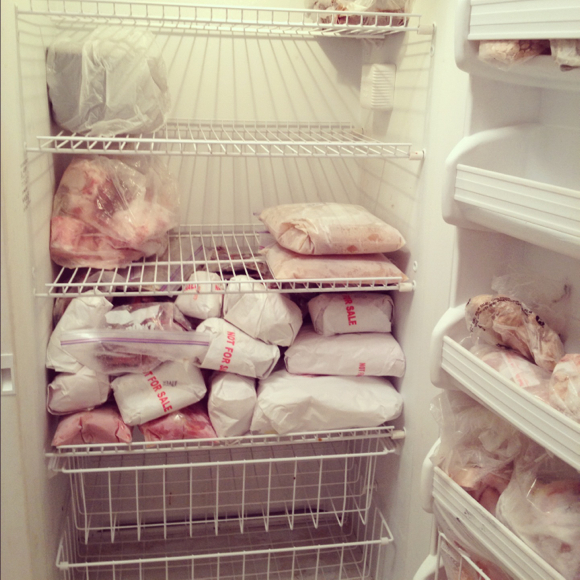
When the freezer has been totally empty, I’ve been able to fit more than 700# in. Because it still had stuff in it, whether I could fit 614# was iffy… But it all fit! *whew*
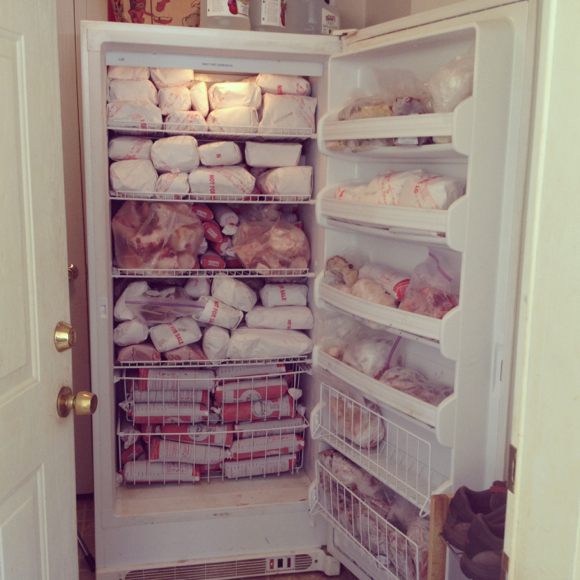
One thing that helps is that we get most of it turned into ground beef. I keep the most prime steaks (like sirloin, T-bone, Porterhouse) and roasts (like rump and tri-tip), but everything else goes to ground beef. This makes it fit more compactly in the freezer, and also more delicious. In our opinion, of course.
I have to say, both my husband and I are nervous about the possibility of the power going out and losing all that meat. We’ve been nervous before, but more so this year… So, I have plans to dehydrate and/or smoke a bunch of this, vacuum seal, and then store without electricity. I will keep you posted about that.
The meat is phenomenal! We’ve had steaks and hamburgers and chili so far. Very tender, flavorful, and moist.
Did you know? The Fundamentals II eCourse includes a bonus lesson on cooking or grilling amazingly tender and moist grass-fed steaks. It is hard to get grass-fed cooking right unless you’re using a technique suited to its unique constraints. If you’re a current member, you have access to it — so check it out. If you’re not a member (yet) check us out here.
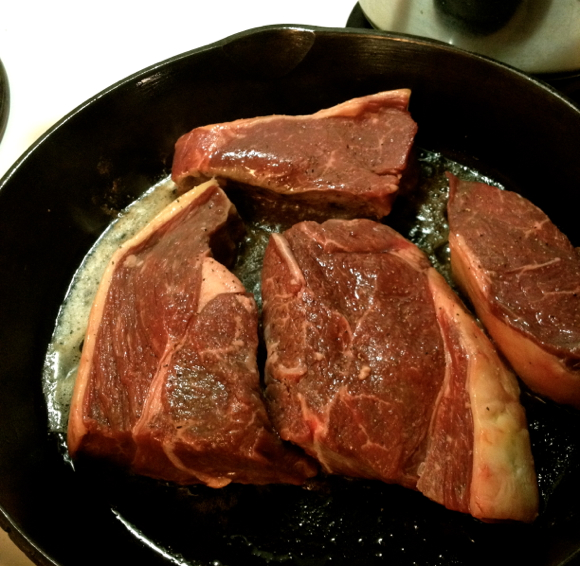
One thing I did not expect was to get back so much fat! Our normal local grass-fed beef source is excellent, and I’ve always been happy to bring home two bags of fat to render into tallow. Well, this time, we got five bags of fat — which absolutely would not fit in the freezer. That meant I had to start rendering tallow ASAP.
This is just one of the bags. Can you tell that it is quite large? Like a foot by a foot. Imagine five of those. I packed them in coolers with ice from the truck stop down the road, and got to work rendering.
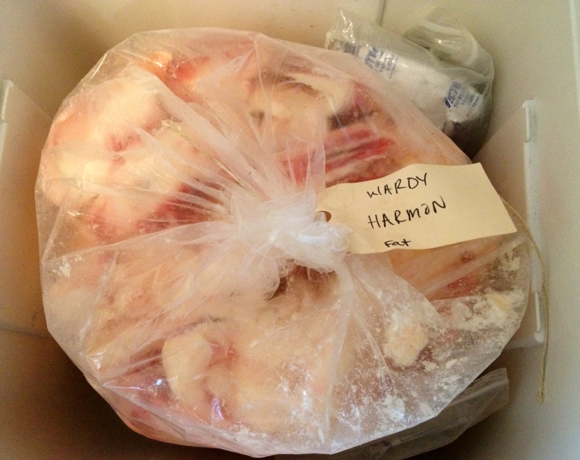
Thankfully, I have an abundance of crockpots. Though you can render in the oven or on the stove-top, I find crockpots the most convenient because there’s not so much monitoring involved or chance of toasting the fat.
I know it may seem excessive that I have five crockpots, but let me explain. 😉 One of them is tiny and great for keeping small amounts of food warm. One crockpot is old and devoted to soapmaking (but can be used for other purposes if I need it). Another is actually a roaster oven. The other two crockpots are always in use for stock, beans, roasts, etc. So you see… it all makes sense!
Anyway, I couldn’t render the tallow in the house — with all that fat, I knew it would take days and I couldn’t fathom heating up the house like that. The weather was really hot at the time. So I set up my rendering project on the front porch. (It was a good thing, too, because it took five days, pots running 24/7, to finish it all.)

Basically, the process of rendering involves low heating and ladling off the melting fat. Here are more detailed instructions. In that post, I’m rendering goat fat. It doesn’t matter what fat, though. The process is the same.
(Standard and premium members of my unlimited online classes — you get a rendering fat how-to video as your thank you video for August 2012. It will be up in your account by the weekend. I’ll send an email when it is ready.)
This fat was quite yellow — that’s because the cow was 1/2 Jersey. It’s a breed thing. The two jars on the left are full of cooled tallow, while the jars on the right are holding hot, liquified tallow.
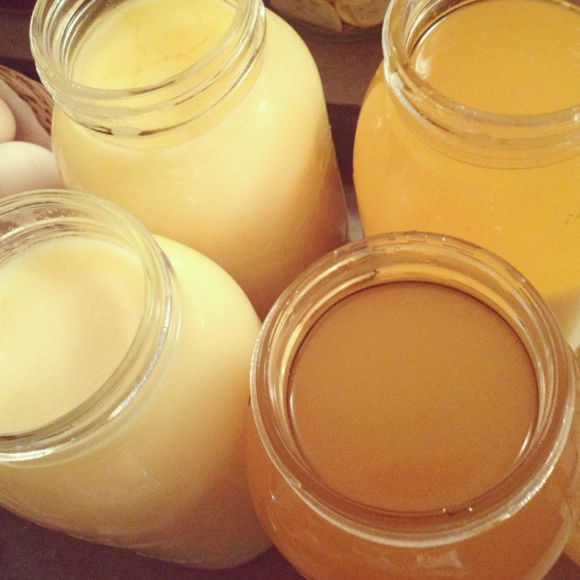
So… quick math here. 5 hugs bags of fat, 5 days of rendering 24/7, and we netted 8-1/4 gallons of tallow. I am still shaking my head in disbelief.
We *think* our cow turned out so well because: 1) she nursed on her mom, a Jersey cow, for at least six months, 2) we fed her the same dairy-cow-quality hay through the winter as we did our dairy cow, and 3) while she was 1/2 Jersey, she was also 1/2 Red Angus. 🙂
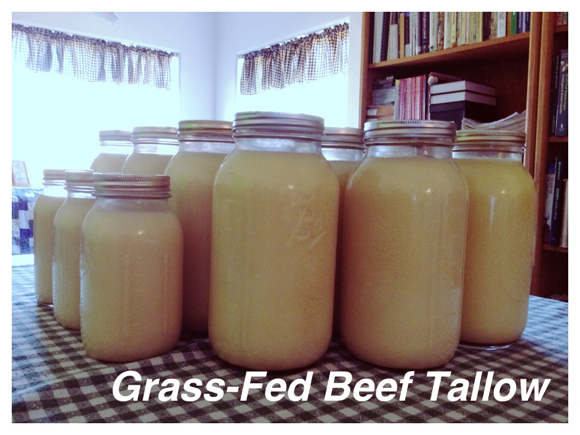
How can tallow be used? Wherever you use fat in cooking, like butter or ghee or coconut oil. I may also make soap out of it.
It is best to store tallow in a cool location. This is where I have trouble. Obviously, my freezer is not going to fit all that! And I don’t have a cellar. In the past, I’ve stored jars of rendered goat fat in the pantry and they were not rancid even more than a year later. Oregon stays cool most of the year.
So, once again, storing in the pantry is really my only option. Except that with this tallow, I vacuum sealed the jars with a FoodSaver with jar sealer accessory. I think they will be fine.
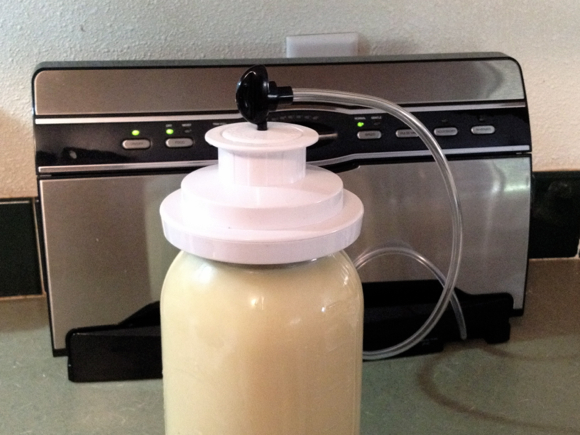
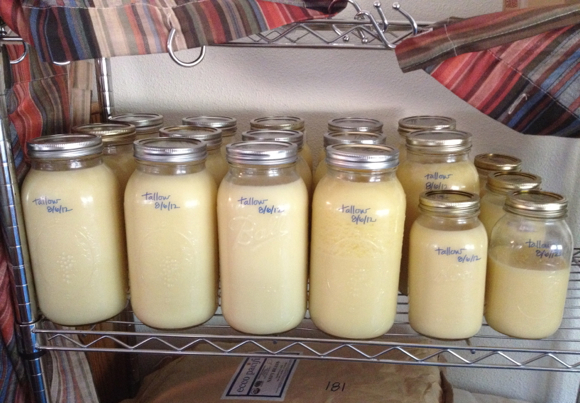
Do you render your own tallow or lard? Any tips to share? Any questions about the process? Please share. 🙂
We only recommend products and services we wholeheartedly endorse. This post may contain special links through which we earn a small commission if you make a purchase (though your price is the same).


I am very impressed with your diligence here, and the little sidenotes on how many crockpots you have. I have never made tallow, so I will bookmark this when we get our next cow. And you’re saying the crockpot method works just fine for lard as well? The lard I have is frozen. Do I just put the frozen lard into the crockpot?
Kamille — Yes, the crockpot method works for lard as well. Any animal fat. Cutting it up smaller makes it go faster, and putting frozen fat in the crockpot is fine. My fat is almost always frozen. 🙂
Do you weigh your beef when you get it home? I’ve found that [what my butcher calls] hanging weight is NOT my take-home weight. We had a large half last year – 400# and some change – but my boxes were much closer to 200 lbs total. My guy says there is a lot that’s trimmed out (certain bones, and I haven’t done the tallow thing before) even from the hanging stage, plus if you have it hang a while (we do 10 days to 2 weeks) it dehydrates quite a bit too.
Our first ‘homegrown’ beef is still on the hoof, but we’re very excited to have it!
It’s pretty typical that your hanging weight is around 60% of the weight for the freezer. It would be more if you wanted bones, organ meat, and fat.
EllaJac and Elisabeth —
Good points, both. I didn’t weigh it when I brought it home. We kept the organs — that was right after the slaughter; they didn’t go back with the butcher. The hanging weight would have included all the bones and fat, which I got afterward. Did I get all the bones? I’m not sure. I certainly got a lot of them (two bags of the same size as the fat bags).
And I totally forgot about it losing weight during the hanging. So, it probably was NOT 614# going in the freezer.
Oooh, I love a full freezer, but I also get concerned about power outages. I can’t wait to read more about preserving your meat without the freezer.
I know you said you use the tallow as you do butter or other oil, but how does it taste? Do you use it in baked goods? Just to sautee veggies? So interested to know!
Beef tallow makes the second best grease for deep frying french fries. Eat them hot. No aromas. Beef fat cannot soak up or expel smells from foods fried in it and can be reused indefinitely. It can also be heated to 400° without smoking. (Duck fat reigns king for frying potatoes, BTW)
And I will definitely ask for the fat when we butcher in the fall. I had no idea you could get gallons of tallow!
Do you make biscuits using tallow?
Wow, Wardee, you really had your work cut out for you! 🙂
I’ve rendered lard and tallow a few times, but on a miniscule scale in comparison 😉
If you don’t mind, I’m curious about what you did about the bones that your ground beef was trimmed off of. (I’m with you on having mostly ground beef.) Do you have lots of pounds of marrow and knuckle bones too?
What to do with all those bones? Especially knuckles. I simmered moose bones on our outdoor wood stove for 48 hours. I added two tablespoons apple cider vinegar to pull nutrients out of the bones. 36 quarts of amazing bone broth. I pressured canned them for storage. The BONUS! you get MORE tarrow! I got 3 quarts of tarrow from bones!
Wardee, using the crock pots is just brilliant. I’m wondering, how will you store the bones and cartilage? Or, did you immediately use it to make stock?
Wardee, thanks for sharing and taking pictures! This year for the first time we will be keeping all our fat from pigs and beef. I also freeze chicken fat.
Have you ever pressure canned tallow? I just read an article in GRIT about pressure canning lard. To alleviate the power outage worry, we are planning to pressure can some of our meat that will be used for soups, stews, casseroles, etc. With limited freezer space we’ll probably make stock right off and pressure can that too.
I admire your lineup of crockpots–I have a few and find them indispensible!
Love seeing your freezer full! Yours is far better organized than mine. Not sure if you used the same butcher in the past…but I will tell you that I have had the ground beef in tubes many times and I do not like it. I have to pay extra to get ground paper wrapped like the rest…but it is worth it for all the times the slick frozen tubes have slipped through my hands to the concrete (dirty) barn floor and ripped the plastic. The red dye on the plastic has also permanently red-stained my white defrosting pan. I didnt know I could ask for ground beef…well and pay for it…in paper. Want others to know they can ask. Frequently, there is beef in that squeezed past the tube ties, so be sure the entire tube and tie end are completely in your defrosting container. Love grass fed beef!
Your handwriting on the tallow jars is so pretty, Wardee. What type of pen did you use?
We ask for the ground beef to be left unpackaged and we pack it up ourselves in various sizes according to what will be needed at a later time. Its quick to pack your own and cheaper as the butcher has not had to pack it up.
As for the hanging weight…you will never get the same weight once its cut and packaged even if you keep the bones and fat. I am inspired to render my own tallow now though but maybe not on such a grand scale!
We have a chest freezer with an alarm on it for freezer failure problems. For power outages, we have a generator we could plug our freezer into in an emergency. However, our chest freezer is -2 degrees and can go a day or two without anything getting near the freezing point, as long as we don’t open our freezer in that time. So, even though we live at the end of the priority list for getting our power turned back on, we haven’t actually had to use the generator for that purpose.
Wonderful! Your freezer looks happy, full of all that meat.
I’ve never rendered tallow, but I’m about to check out your more detailed instructions to see what it would involve.
We also prefer our beef minced. There’s soooo much you can do with it. It makes dinner time seem full of more variety than if you just have casserole after casserole.
Hi,
You’ve got so much tallow, you may want to consider trading it with friends for other products you don’t have time to make. Or give it away as a gift… I know there a lots of people who would love to have tallow, but don’t have the good fat to work with..
I purchased a whole beef from a local farm and asked for all the fat so I could render it into tallow and all I got was one small package. This is a grassfed beef, but not a jersey. Why the discrepency I’m wondering? I’ve always been told grassfed beef is much leaner, yet that was not your experience. I had hoped for a lot more fat than what I got. What are your thoughts? Thanks!
I read that if the power goes out, putting a blanket over your freezer will buy you a couple days. I would use an emergency blanket too.
They also suggested keeping water bottles in the freezer to pop in the fridge if the power goes out.
Thanks for all the tips in the article!
What is the difference between lard and tallow?
Mary Kay — Lard is from pigs, tallow is from cows.
I use roasting pans to render tallow & lard. They are like a huge crock-pot. I then put a jar funnel on top of quart jar with a very fine strainer in it and pour the hot fat into jar up to 1/2″ of top. Place on lid and ring. Place jars upside down on top of towel to cool.
Then we store in a dark cool place for up to a year, but it never seems to last that long 🙂
On the tallow: Do you trim off all the sinew and meat, or just toss it straight in the crockpot? How often do you usually stir it to keep it from burning?
Could you please post or e-mail me more pictures of your pantry curtains? We have those same shelving units, and I have thought of making curtains, but wasn’t quite sure how to go about it. It would make my kitchen look alot nicer! Thank you for an excellent post!
Sarah — I tossed it all in. I stir every few hours to prevent sticking.
Here’s more info on the curtains (they’re shower curtains 🙂 ):
http://suchtreasures.com/2012/04/05/i-cut-a-shower-curtain-in-half/
Thank you! We have a side of beef coming next week, so this will come in handy. I will definitely be looking into buying some shower curtains! 🙂
This is incredible…we buy 1/4 grass-fed beef from my aunt and I’ve asked for the bones to make stock and for my dog but have never thought to ask for the fat! Does the tallow have a strong flavor? Would you use it for sauteing vegetables or something (like instead of olive oil?) We are also about to buy 1/4 pig, could I do the same thing for that fat and use it for the same purposes? I think you maybe just opened up a whole new world of possibilities! lol! Also, did you have to pay for the fat or did they just give it to you with your cuts?
Thanks! Sorry so many questions! 🙂
Mrs. iHB — It smells and tastes a bit meaty, so I won’t use it for pastries. Pure leaf lard/tallow (explained in the post) can be used for pastries as there’s no meaty taste.
They didn’t charge us extra because it was part of the hanging weight.
Yes, you can do it with pig — in this case, it is called lard. 🙂
I’ve had experience rendering large amounts of lard. It is much easier and faster if you have the butcher grind it. When we have done our own butchering, we cut the fat into 1 inch pieces. I have rendered in a large canner on the stove, but I prefer to render in a cast iron kettle over a small fire. I can render 8 to 10 gallons in less than 6 hours. Yes, it does require my constant attention, but I like that it can be done in 1 day. We lived off grid for 5 years and had no way to freeze meat. So I have canned pork, chicken, and beef . It is a great way to store meat without worrying about power outages and very convenient to have for quick meals.
Lisa — Thanks for sharing that! Great tips. 🙂
Hi Lisa,
I was wondering if you would want to share how you can you beef, chicken and pork? How much psi and for how long? Thank you .
Wardee – We are getting 3/4 of a cow today (the most we’ve ever had!) and will receive one bag of fat. I have never rendered tallow before, but am ridiculously excited about it! I’m planning to use my slow cooker, but am undecided as to whether to do on the kitchen counter or on the back patio. On a scale of 1 to 10, how smelly was your tallow as it was rendering?
Thanks in advance! 😀
Mindy — Personally I don’t object to it. It is like having a roast in the oven all day. On a hot day, between that and the heat, it isn’t the best idea. But in the winter or cooler days, I don’t think the smell is overpowering at all. Have fun!
Just wanted to give you a tip on rendering fat. If you grind it first (as if you were making hamburger), and boil it in water, it only takes about a half hour to render. Pour it off in a 5 gallon bucket and the fat floats on top. Easy and quick.
How does your soap turn out when you use soft yellow beef fat? I am rendering fat from a recently butchered cow (275 lbs. from one cow!!! Yikes!) and it is the first time I have not gotten hard white rendered fat. It is soft and yellow. Does the soap turn out soft too?
If you could email me, I would greatly appreciate it. Thanks!
I raise grassfed Texas Longhorns and get the kidney fat when I take one to the processor. If you want to try something really good try deep frying some of your steaks in your beef tallow. (Google Pitch Fork Fondue). It works great if you have an outdoor deep fryer and the taste of the steaks is fantastic.
Seriously? boil and…. that might be genius!!!!
But not a rapid boil… not trying to homogenize the oil and water into skin cream(at least not yet? :-P)
I used the soft yellow tallow to make soap and it turned out just fine. It’s just a little on the beige side though, instead of pure white. But the soap is just about the same quality. 🙂
Teri,
Yes, you can do a rapid boil. The fat renders faster and when it cools, it floats to the top so you can take it off. The grinder method saves A LOT OF TIME!!!
Hi, I make beef broth using grass-fed beef bones. I simmer it for 2-3 days (like Nourishing Traditions cookbook says), then strain and put in the fridge overnight. The next day the tallow has floated to the top. I have been scraping it off, putting it in a plastic yoghurt container in the fridge and using it for frying. The rest is a gelatinous broth and liquifies when heated to make a wonderful nourishing broth for soup. Here is my question: Is this tallow I have properly rendered to use for skin cream? I would really love to know that I don’t have to render the fat separate from the bones. I didn’t get the fat in a separate bag when we got a side of grass-fed beef, only the bones but they have a lot of fat in them, too. Or is there some way to further render my tallow to make skin cream with it?
I have the same question as Renee- I just bought my first share of grassfed beef- But they said that there isnt enough fat on the cows to bother with- I don’t know if when I cook this beef if the tallow I can save after cooking is the same as if I got the fat separated. So can I use it as tallow? For skin care and frying or are their different areas of the cow that provide the proper fat for tallow making and other areas of fat are not good for that? Mine is cut ,cryo vacced and frozen when I receive it- Or would certain cuts of meat have the right fat and I should trim it off for making a tiny bit of tallow to try? Help thanks! Assume I know nothing – cause that is pretty much true LOL
Lori, the tallow leftover from cooking will probably have a strong meaty flavor and/or texture. It would certainly work for frying french fries and cooking. I’m not sure if it will be pleasing for skin care. Though you can certainly try and it might work out fine!
Wardeh, did you trim the tallow any more from the way it came from the butcher? If not, did the bits of meat cause any problem? We just butchered a dairy heifer (a freemartin, so she wasn’t good for anything else) and I’m getting started rendering (and canning and making stock and working the hide and. . . . ) 🙂 She carried more internal fat than any animal I’ve ever butchered and she’s actually marbled which surprised me as she’s 100% dairy and 99% grass fed.
Judy, after I render the tallow I strain it before putting it in jars. That takes care of any bits of meat. Sounds like you got a good one!
Thanks! 🙂
Hello! I live in Spain and it is very challenging to get organ fat. Can I use any grassfed beef fat to make tallow? Will it be similiar or close to the vitamin content found in the leaf fat? Thanks!
Hi, Rocio.
Yes, you can render tallow from any grassfed beef fat. 🙂
I’m not sure of the vitamin content.
~Danielle, TCS Customer Sucess Team